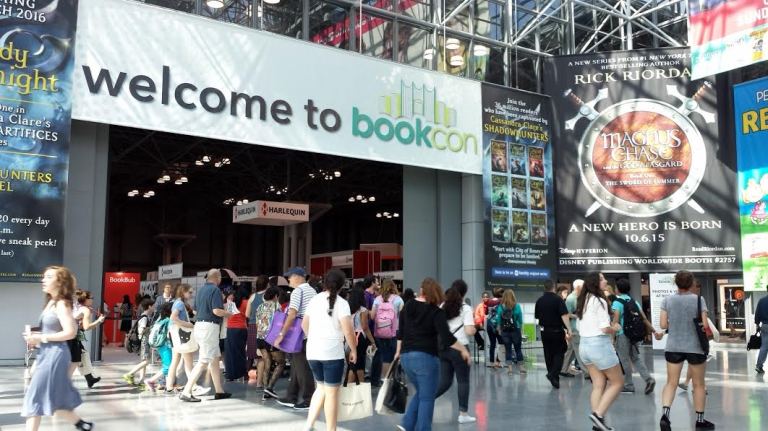‘Publishing Goes Pop,’ Part 2: Is A Fan A ‘Quantified Reader’?
In this second of two articles on a panel at Berlin's Klopotek Publishers Forum, we hear from Michael Bhaskar, Nathan Hull, and Andreas Gall on the question of fandom and how the books industry can leverage it.


Michael Bhaskar: ‘Fans are critical to what it means to be a publisher today’
Historically, publishing meant amplification. “Making stuff available,” Canelo Publishing’s Michael Bhaskar told our Berlin audience.
Putting something into print was enough to amplify it. But actually, now, on the Internet, when everything can be made available automatically, simply having stuff available is no longer amplifying. It’s just hiding it on the Internet. I would argue now that what constitutes publishing is about building audiences. The very core of publishing now has to be about finding readers, building audiences.
“And that is a key change in the whole nature of what publishers do, what they’re about, why we exist” in publishing, Bhaskar said.
The meaning of publishing has changed. People like fans are critical to what it means to be a publisher today.
Bhaskar might well have been warming up for the keynote address with which he opened the 2015 Digital Book Conference on 27 May at BookExpo America in New York. I’d invited him to give a talk titled “Setting the Stage: The Customer as Curator” because his forthcoming book from Little, Brown UK will try to do for the contemporary idea of curation what his 2013 book, The Content Machine (Anthem), did for publishing in digital times: offer context. You can read more about his talk and the conference here, in ‘Putting Readers First’ At BEA: Gatekeepers, Curators, And Too Many Books.
At Klopotek’s Publishers’ Forum in Berlin a month earlier, programming director Rüdiger Wischenbart had created a thematic thread called “Publishing Goes Pop,” a way for attendees to focus on popular-fandom modes of marketing. These are approaches that many traditionalist publishing people haven’t thought were appropriate or achievable for the world of books and reading. At the same time, many are realizing that in order to compete in the digital entertainment world, publishing is going to have to open itself to scalable, pertinent forms of audience-building, particularly among the younger demographic brackets.
In Part 1 of this two-part set of articles, we focused on the comments of ReedPOP executive Lance Fensterman, whose BookCon on 30th and 31st May drew 18,000 ticketholders to the Jacob J. Javits Center. Fensterman talked of a “niche passion” that transforms steady readers into something that can be mobilized in the marketplace: fans.
In this article, Part 2 of the set, we want to hear from the other voices on the panel — Bhaskar, Nathan Hull, and Andreas Gall — to get at some of the other entry points we have into thinking about fandom and how such a populist concept may have relevance for publishing.

First, Bhaskar, and I’m glad to say that he will be joining me on the 15th of October at Frankfurt Book Fair’s Business Club for a special “Hardcore Book Fan Hugging” — the second in a series of three “Hug the Alien” programs that bring together some of the reachier concepts in and near publishing today and help make them more accessible, even actionable.
And he had arrived, in our “pop” session in April, with five points on the topic of fandom well worth reviewing here.
1. The “key change” that Bhaskar defines in what publishing does in the world, as mentioned above, is in the move from amplification to audience-building. Where once it was enough simply to put out a book — boom, amplification — today, that’s not enough. Publishing becomes a question of finding and building audience for what’s being amplified.
2. “The way we make our business” at Canelo Publishing, Bhaskar said, “is not when we have one author with a book, but one author with six books in a series. People need to be very quickly addicted to our books, and that means we focus on two things: story and character. All we want are books [so good] that people will forget about the medium. They won’t care if they’re on an iPhone or an iPad. They have to be gripped by the story. And therein lies the essence of fandom. A fan is someone who’ll download the first book and then download the rest of the books in a series immediately.”
3. “What’s the difference in a fan and an ordinary customer?,” Bhaskar was setting up his own answer: “I’d say there are two key differences. The first is qualitative: the intensity of the relationship between a fan and what they’re a fan of is much greater. Think of someone who likes Barçelona Football Club or Star Trek. When you see a One Direction fan screaming in the audience, crying over Zayn Malik, that is intense, a qualitatively different level of relationship. But there’s also a quantitative difference, too. In a typical customer interaction they’ll buy something, they might use it, and that’s it. But a fan will come back, again and again and again and again.”
4. “What does the Internet mean in all this? Firstly, fans are advocates, evangelizers, they’ll talk incessantly about whatever they’re fans of. …The network empowers fans in a way that lets them be very public, they can make their voice be heard…They can sell products and they can break products.”
 Here, Bhaskar went on to say that the Internet also “creates a new economics of fandom.” And he drew on the work of Nicholas Lovell, whose The Curve: How Smart Companies Find High-Value Customers was published in 2013 by Penguin’s Portfolio imprint.
Here, Bhaskar went on to say that the Internet also “creates a new economics of fandom.” And he drew on the work of Nicholas Lovell, whose The Curve: How Smart Companies Find High-Value Customers was published in 2013 by Penguin’s Portfolio imprint.
On the Internet where things tend toward “free”…Nicholas Lovell says it doesn’t matter what your price is. If there’s free entertainment on YouTube, that’s causing a problem. But fans aren’t willing to spend just 10 euros on a book. They’re willing to spend 500 euros on a special edition and one fan is willing to spend 5,000 euros on going to meet the author and having dinner with him…So the whole pricing structure around fandom is based around a few key super-fans willing to spend huge amounts of money engaging with the product. The difficulty is that we all work in businesses that still have the old industrial model. How can we adapt and get what Nicholas Lovell calls this “curve” pricing structure?
5. Here, in his last point, Bhaskar put forward the idea that the kind of fandom we were talking about and debating in terms of publishing’s future “is causing a kind of shift, even in the nature of capitalism. Fandom is turning up in areas that are completely unexpected.” As examples, Bhaskar cited IKEA fan conventions and Warren Buffett’s famous Berkshire Hathaway shareholder events in Omaha.
All of which led ReedPOP’s Fensterman to muse, maybe a bit longingly, on “BerkshireCon.”
Nathan Hull: ‘Layer Upon Layer Of Data’
In his incisive comments on the panel, the Scandinavian ebook subscription service Mofibo’s chief business development director, Nathan Hull, made the case for data as a major channel to potential fan bases and their interests.
“To take the most extreme model,” Hull said, “in Denmark, we are actively working with one of the really big publishers — which are in general the slowest to move — to use data to create fiction in a completely different way.” He went on:
This may make some people cringe. And I’m not saying that it can create the perfect crime novel. But…some of the data we supply shows the reading speed at which people are moving through a book. In the parts of the book in which you’re establishing the characters and building up the plot, people tend to move very quickly. Moments of high drama and high suspense, they’re eating it up, they’re going right through. But when it get a little bit dry and uneventful, we can really see that people are a lot slower. We also can see that they tend to skip sections.
That’s just one book. But think of that as a genre. We can put layer upon layer upon layer of such data into this. A lot to play on emotions and tone. That’s what we’re working on next.
Hull says that Mofibo’s system can tell what time of day its readers are active in various titles.
We’re live in Denmark and Sweden, we’re about to go live in Holland. In Denmark and Holland, everyone cycles everywhere. There’s a lot of similarities between the countries. We could start to tailor the correct reading experience to the correct device at the correct reading time. We’ve added audiobooks to the service now, and we’re starting to get really intelligent information on what people are happy to be reading and what they want to continue [to “read”] audibly.
How does this play into the fandom question?
Let’s say that a publisher has a major release ahead and believes that the book has the potential to generate the kind of fan-level intensity of interest that Bhaskar and Fensterman understand. Then a subscription service’s data, Hull said, is the way to identify the readership subset most likely to support the book.
We can tell you where they’re sitting, the times of day they’re reading, what devices they’re on — for all your advertising campaigns.
This could affect which books a publisher might want to acquire, Hull said. “You could go back to the office” after looking at Mofibo’s data on a given author’s canon, “and say, ‘You know what, nobody finished your last book. Write a different ending.'”
In answer to my question about privacy issues, Hull said that not only is Mofibo’s data anonymized but that its collection is entirely opt-in on the part of the customer — and contributing to a deepening pool of knowledge that may someday show a publisher a center of fandom waiting to be intrigued by a new book or author.
There’s more about Mofibo’s operations and promise in an article Hull wrote for us at The Bookseller’s The FutureBook in April. Nathan Hull: Ebook Subscription Data Is ‘Incredibly Rich’.

Andreas Gall: ‘All I Need Is The Right Story’
“Who is a fitness guy here?” Andreas Gall asked the Publishers Forum assembly. “Who is wearing a sensor on his body here?”

Our good friend and colleague Richard Nash — whose speech, “When Editors Eat Robots,” at Stockholm’s Next Chapter we wrote about here —raised his wrist, of course, with its Jawbone. My FitBit is always with me.
“I tell you,” Gall said, “this is the next thing: mood-driven story selections.”
Gall has been spotting “next things” for some time. He’s the chief technology officer of Red Bull Media House, which he helped launch in Salzburg in 2007. Media House works in cultural, sports and lifestyle events, frequently in partnership with other companies and from bases both in Austria and in Los Angeles.
“When you’re in a fine mood,” Gall was saying to us in his presentation in Berlin, “perhaps I offer you a very fine book. Or maybe I offer you a very special TV show or movie.”
Three years ago, Gall said, he experimented with mood-detection sensors on athletes and found that the implications for entertainment delivery were “like changing from black-and-white to color.” It was the ability to know something of how the target customer was feeling that was making the difference. No longer might a distributor function primarily as a blind delivery system to shove a given product toward a potential user. Instead, that distributor now could know something of the emotional climate in which the suggested product might land.
Where Gall sees this going has a great deal to do with the promise of social media. “We started nine years ago with 200,000 Facebook followers. Now, we have 40 million. When I can use 40 million invitations to Facebook fans, I don’t need classic advertising windows anymore,” he said.
“All I need to do is find the right story. With that, I can inspire them.”
Having a background in “old media” — radio, television, music — Gall assured his publishing audience that he understands the trepidation they feel when asked to think in terms of looking for avid fandom in a readership.
And that step, he told them, is toward the “quantified reader,” toward a potential customer-reader whose mood, whose receptivity, has been measured and used to help determine which product is offered and how the approach is made: a fan is a person whose most ardent interests are engaged.
And as uncomfortable as it might be at times for the bookish world to think of fan-level enthusiasm as its goal, Hull said, that’s exactly where the industry needs to put its next efforts.
“I want to motivate you,” he said, “to take the big step.” ![]()




